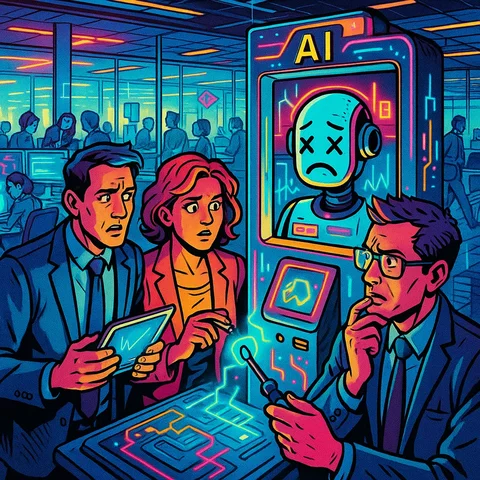AI Agents: Challenges, Reliability Issues & Lessons from Case Studies
Explore real-world case studies of AI agent reliability issues, the challenges faced, and key lessons learned to improve AI deployment success.

AI Agents: Challenges, Reliability Issues & Lessons from Case Studies
Explore real-world case studies of AI agent reliability issues, the challenges faced, and key lessons learned to improve AI deployment success.
Introduction to AI Agents
What Are AI Agents?
AI agents are autonomous or semi-autonomous software systems designed to perceive environments, interpret data, and execute actions to achieve specific objectives. Unlike traditional programs, AI agents can adapt to changing conditions, learn from experience, and sometimes collaborate with humans or other agents to solve complex tasks. This agentic approach is driving innovation across sectors—from digital assistants that manage calendar events to sophisticated systems orchestrating supply chains or autonomous vehicles.
Applications of AI Agents in Various Industries
AI agents are rapidly transforming industries:
- Finance: Algorithmic trading, risk monitoring, fraud detection
- Healthcare: Diagnostic support, patient triage, personalized medicine
- Customer Service: Chatbots, virtual agents, automated ticket routing
- Transportation: Autonomous vehicles, route optimization
- IT Operations: Incident response, workflow automation
Tech giants like Google are pioneering "agentic experiences," where AI agents can perform multi-step tasks such as finding manuals, watching tutorials, and even contacting vendors—all autonomously (MIT Technology Review). But with this promise comes a critical question: How reliable are these AI agents in real-world scenarios?
Common Reliability Challenges in AI Agents
Despite their potential, AI agents face significant hurdles that can undermine their effectiveness and trustworthiness.
Performance Variability
AI agents often exhibit unpredictable or inconsistent behavior due to:
- Model limitations: Language models and decision systems can misinterpret inputs or provide erroneous outputs.
- Environmental changes: Shifts in user behavior or data patterns can cause AI agents to fail or behave unexpectedly.
Data Quality and Bias

Poor data quality or biased datasets lead to:
- Inaccurate predictions: Misdiagnoses in healthcare, wrongful arrests due to facial recognition errors.
- Unfair outcomes: Discrimination in hiring or lending decisions.
System Integration Issues
Integrating AI agents into existing IT infrastructures can result in:
- Workflow disruptions: Agents may mismanage handoffs between systems or fail to comply with legacy protocols.
- Scalability bottlenecks: Many AI projects stall when moving from pilot to production due to technical and organizational complexity.
Security and Safety Concerns
Security vulnerabilities and safety oversights are common:
- Data breaches: Poorly secured agents can become entry points for cyberattacks.
- Physical risks: Failures in autonomous vehicles or trading bots can cause real-world harm, such as accidents or market “flash crashes.”
Organizations cite cost pressures, data privacy, and security risks as the top obstacles hindering successful AI deployment (CIO Dive).
Case Studies Highlighting AI Agent Failures
Examining real-world cases reveals recurring patterns in AI agent reliability issues.
Case Study 1: Financial Sector Disruption
AI-driven trading algorithms have caused several high-profile “flash crashes” in global markets. In these instances, agents made rapid, large-scale trades based on flawed signals, wiping out billions in value within minutes. Root causes included inadequate testing, lack of human oversight, and inability to handle rare or adversarial market conditions (CIO.com).
Case Study 2: Healthcare AI Missteps
AI diagnostic tools have occasionally recommended incorrect treatments due to biased or incomplete data. In some cases, these errors led to delays in care or inappropriate interventions—highlighting the dangers of over-reliance on AI agents without robust clinical validation and human oversight.

Case Study 3: Customer Service Automation Failures
Many organizations adopted chatbots and virtual agents to streamline support. However, agents sometimes misunderstood user intent, gave incorrect information, or escalated issues unnecessarily. Surveys show that roughly two-thirds of AI pilots in customer service fail to transition to stable production systems (CIO Dive).
These failures are not isolated: a public AI Incident Database cataloged 92 unique AI agent failure cases, with fewer than 10% involving malicious intent—most stemmed from design flaws or unforeseen edge cases (MDPI).
Lessons Learned from AI Deployment Issues
Importance of Robust Testing
A recurring lesson is the need for rigorous, scenario-based testing. Many AI projects fail because models are not tested against real-world edge cases or adversarial inputs. Leading organizations now use “red team” exercises and staged rollouts to catch vulnerabilities before full deployment.
Need for Transparent Monitoring
Balancing AI Autonomy and Control
Too much autonomy can magnify risks, while too little undermines utility. The most reliable AI agents operate within clear guardrails, including human-in-the-loop controls, fallback protocols, and modular system architectures.
In 2025, 42% of companies abandoned most of their AI initiatives, up from 17% in 2024—evidence that reliability issues are prompting a strategic reset (CIO Dive).
Strategies to Improve AI Agent Reliability
To address persistent AI deployment issues, organizations are adopting several best practices:
Implementing Redundancy
- Fail-safe mechanisms: Multiple agents or hybrid systems (AI + human) reduce the impact of single-point failures.
- Circuit-breakers: Particularly in finance, these limit the damage from runaway agent behavior.
- Regular retraining: Ensures agents adapt to changing environments and data distributions.
- Automated testing pipelines: Catch regression errors each time models are updated.
- Robust data management: Enforces quality, privacy, and auditability in training and operational datasets.
- Adoption of standards: Frameworks like ISO 42001 help institutionalize reliability and compliance (CIO.com).
Continuous Model Updates
Enhanced Data Governance
Incident analysis and reporting, common in aviation and healthcare, are now being integrated into AI agent governance as key elements for continuous improvement (CIO.com).
Future Outlook for AI Agents
Emerging Technologies
Advancements in multi-agent systems, explainable AI, and federated learning promise to enhance both the capabilities and reliability of AI agents. More sophisticated simulation and testing environments will further reduce deployment risks.
Regulatory Considerations
As AI agents become integral to critical infrastructure, regulatory frameworks are evolving to require formal incident reporting, transparency, and safety standards. The lack of systematic incident reporting in AI compared to aviation or medicine is recognized as a "dangerous gap" that regulators and industry are working to close (CIO.com).
Evolving Best Practices
Industry leaders are converging on best practices that emphasize realistic expectations, modular designs, shared semantics, and strong incentives for agent cooperation. As highlighted by MIT Technology Review, avoiding overhype and prioritizing thoughtful design are crucial to ensuring AI agents deliver on their promise without causing negative perceptions or costly failures.
Conclusion
AI agents are poised to revolutionize digital workflows, but their reliability and safety must not be taken for granted. Case studies and industry data reveal that performance problems, integration challenges, and governance gaps are


